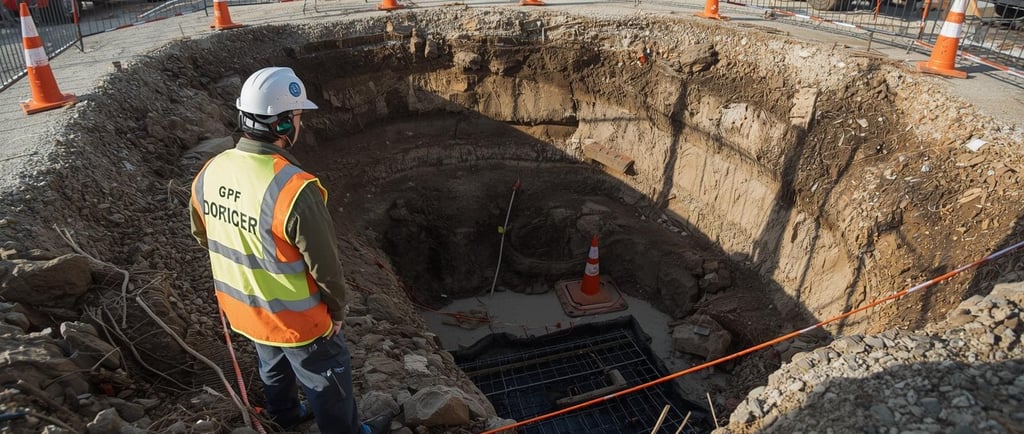full excavation revision for HSEO's
Hi safety departments I hope this blog will touch your heart because I am going to explain almost everything about excavation in this post in a very easy way, as said that easy pizy japanese.
SAFETY FIELD FOR LEARNING EARNINGSAFETY FIRSTHOME
earninglearnings.com
9/5/20253 min read


Hi safety departments I hope this blog will touch your heart because I am going to explain almost everything about excavation in this post in a very easy way, as said that easy pizy japanese.
Excavation
Here is a comprehensive list of every point about excavation from CSM "Construction Safety Manual" including all technical details.
Note: these information are the refresher points for the experienced candidates not for freshers.
Definition
· Excavation: Any man-made cut, cavity, or depression in the earth's surface formed by earth removal.
Simply, digging of earth.
Trench Definition
· Trench: A narrow excavation where the depth is greater than its width, but not more than 15 feet (4.57 meters) wide at the bottom.
Types of Excavation
· Mechanical Excavation: Done using machines (e.g., Excavator, trencher, backhoe loader).
· Manual Excavation: Done manually using tools like shovels.
Competent Person
· A person with sufficient knowledge, authorization, training, and experience to identify existing and predictable hazards and take prompt corrective action.
Access and Egress (Technical Requirement)
· Safe means of access/egress (ladder, stairway, ramps, steps) are required at a depth of 1.2 meters or more.
· The means of egress must be located so workers do not have to travel more than 7.5 meters (25 feet) laterally within the excavation.
Confined Space Classification
· An excavation is considered a confined space at a depth of 1.2 meters or more.
Underground Utilities
· Facilities buried underground (e.g., electrical cables, communication cables, water, gas, or other means of pipes).
Cave-In
· The separation of a mass of soil or material from the side or beneath an excavation.
Cave-In Protection Methods
· Sloping (90°, 53°, 45°, 34°)
· Benching
· Shoring
Soil Types (Technical Classification)
· Stable Rock
· Type A: Cohesive or cemented soil (e.g., clay, marl) 90°
· Type B: Less cohesive soil (e.g., mix of sand, rocks, and clay) 53°
· Type C: Least cohesive soil (e.g., gravel, sand, muddy or freely seeping soil) 34°
Maximum Allowable Slope Angles (For excavations less than 20 feet deep)
· Stable Rock: 90° (Vertical)
· Type A Soil: 53° (3/4:1 ratio - 3/4 ft out for every 1 ft down)
· Type B Soil: 45° (1:1 ratio)
· Type C Soil: 34° (1.5:1 ratio)
Spoil Pile Setback
· Soil/spoil must be set back at least 2 feet (0.6 meters) from the edge of the excavation.
Hazards Associated with Excavation
· Underground utilities (strike risk)
· Cave-in (sudden collapse of walls/soil)
· Falls of personnel, materials, and equipment into the excavation
· Presence of toxic gases (e.g., Hydrogen sulfide) or oxygen-deficient atmospheres (19.5 to 23%)
· Slips, trips, and falls
· Struck-by moving equipment (e.g., excavator, dump truck)
· Water accumulation
· Presence of snakes, scorpions, or other reptiles (biological hazards)
· Improper access and egress (every 7.5m or 25f)
Control Measures / Requirements / Procedure
· Obtain a valid permit to work.
· Ensure pre-excavation and excavation checklists are filled out to ensure compliance.
· Clearly mark underground utilities. Heavy equipment must maintain a safe distance. (6m)
· Ensure all equipment (excavators, dump trucks) is inspected and has a valid inspection sticker. (monthly inspection sticker) (4 types of colour code)
· Operators must be certified.
· Post signage (e.g., "Keep Away," "Deep Excavation" “entry point” "Emergency exit”).
· Ensure proper supervision (e.g., hole watch, foreman, job supervisor and confined space entry supervisor) are in place.
· Barricade the area 1 meters away from the edge to prevent unauthorized entry.
· Assign flagmen (spotter) to assist operators and control traffic flow.
· Install safety devices on equipment (e.g., PWAS, reverse alarm, beacon light. now camera also mandatory).
· Install a de-watering system to remove accumulated water.
· Apply cave-in protection methods (sloping, benching, shoring).
· Provide adequate warning lighting if the excavation is near vehicular traffic at night.
Key Technical Standards & Measurements
· Trench Width: ≤ 15 ft
· Access/Egress Depth: 1.2 m
· Max Lateral Travel to Egress: 7.5 m (25 ft)
· Spoil Setback: 2 ft (0.6 m)
· Barricade Distance: 1 m from the edge of excavation
· Slope Angles: 90° (Rock), 53° (A), 45° (B), 34° (C)
Remember these informations are helpful for those who already know a little bit about CSM and aramco site. This information is just a refresher post for the experienced safety officers or safety supervisors or even for others as well.
So, keep in touch. I will share from time to time these types of information safety related on this earninglearnings.com website.
Best blog posts
full excavation revision for HSEO's
The Hidden Stories of Workers: A Journey of Earning, Learning, and Living Between Lines
The Soil Compactor and the Secret to Success: Lessons from the Ground Up
Summary of the Construction Safety Manual (CSM) – 5th Edition
Unlocking Safety Excellence: A Look Inside the Saudi Aramco Construction Safety Manual CSM (5th Edition)
Mastering Construction Safety: Why the CSM is Your Ultimate Jobsite Guardian
Smart Planning for Earning and Learning: A Path to Growth and Stability
Why the Saudi Aramco Construction Safety Manual Is One of the Most Important Books in the Industry
#ExcavationSafety #DigSafe #TrenchSafety #SafeExcavation #ExcavationHazards #DiggingSafely #ExcavationAwareness #ExcavationRiskManagement #WorkplaceSafety #ConstructionSafety #OSHASafety #JobSiteSafety #SafetyFirst #ZeroHarm #StopAndThink #SafetyCulture #TrenchSafetyWeek #TrenchShoring #UtilityLocating #CallBeforeYouDig #811BeforeYouDig #KnowWhatsBelow #ShoringSafety #TrenchCollapsePrevention

